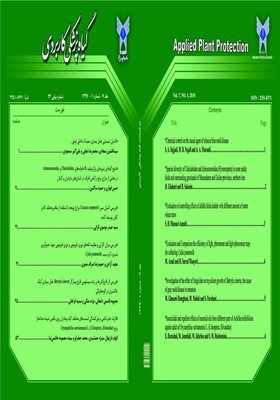تنوع گونهای زنبورهای پارازیتوئید بالاخانوادههای Chalcidoidea و Ichneumonoidea در بخشی از مزارع برنج و اراضی اطراف در استانهای مازندران و گیلان
محورهای موضوعی : آفات گیاهی
1 - گروه گیاپزشکی دانشگاه آزاد اسلامی واحد یادگار امام خمینی (ره) شهرری
2 - گروه حشرهشناسی، دانشکده کشاورزی، دانشگاه آزاد اسلامی واحد قائمشهر، قائمشهر، ایران
کلید واژه: کنترل بیولوژیک, Chalcidoidea, پارازیتوئید, Ichneumonoidea,
چکیده مقاله :
در پژوهش حاضر، تنوع گونهای زنبور های پارازیتوئید بالاخانوادههای Chalcidoidea و Ichneumonoidea (Hymenoptera) در برخی مزارع برنج و اراضی اطراف آن ها در استانهای مازندران و گیلان مورد مطالعه قرار گرفت. در مجموع 39 گونه زنبور پارازیتوئید از دو استان مزبور جمعآوری و شناسایی شدند. پارازیتوئید های جمعآوری شده متعلق به خانوادههای Chalcididae (2 گونه از 2 جنس)، Encyrtidae (5 گونه از 5 جنس)، Eulophidae (4 گونه از 4 جنس)، Mymaridae (1 گونه)، Trichogrammatidae (2 گونه از 1 جنس)، Braconidae (15 گونه از 13 جنس) و Ichneumonidae (10 گونه از 10 جنس) بودند؛ سه گونه شامل Cerchysiella planiscutellum (Mercet, 1921)، Ginsiana carpetana (Mercet, 1921) و Pediobius brachycerus (Thomson, 1878) برای اولین بار از فون ایران گزارش شدند. نتایج حاصل نشان داد که فون غنی و ارزشمندی از زنبور های پارازیتوئید در شالیزار های شمال کشور وجود دارد که در صورت حمایت میتوانند نقش کارآمدی در کنترل آفات مختلف مزارع برنج داشته باشند.
In this faunistic research, species diversity of parasitoid wasps (Hymenoptera) of two super families Chalcidoidea and Ichneumonoidea was studied in some paddy fields and surrounding grasslands of Mazandaran and Guilan provinces (northern Iran). In total, 39 species within seven families were collected and identified: Chalcididae (2 species, 2 genera), Encyrtidae (5 species, 5 genera), Eulophidae (4 species, 4 genera), Mymaridae (single species), Trichogrammatidae (2 species, 1 genus), Braconidae (15 species, 13 genera) and Ichneumonidae (10 species, 10 genera). Upon the results of this investigation and the other published works, a diverse and rich fauna of parasitoid wasps are active in paddy fields of northern Iran, which can be efficient biological control agents under impressive conservation. Additionally, introducing these beneficial insects to farmers and training them to support natural enemies in various aspects will result to safekeeping of agroecosystem and natural ecosystems, and also producing of safe and organic crops.
_||_


